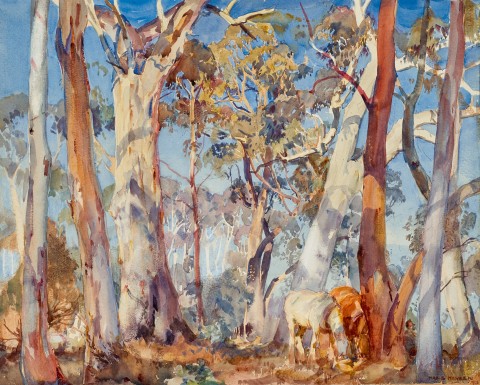WHITE GUMS, 1926
HANS HEYSEN
watercolour on paper on compressed card
33.0 x 40.5 cm
signed and dated lower right: HANS HEYSEN / 1926
signed, dated and inscribed with title verso:
“White Gums”/ Hans Heysen – / Ambleside / Sth Aust. 1926
Private collection
Sotheby’s, Sydney, 14 August 1990, lot 275 (as' Two Horses Grazing Amongst the Gums')
Joseph Brown Gallery, Melbourne, acquired from the above
The Cbus Collection of Australian Art, Melbourne, acquired from the above on 20 August 1990
Possibly: Exhibition of Paintings by Hans Heysen, Fine Art Society’s Gallery, Melbourne, 18 November – 27 November 1929, cat. 15
on long term loan to Geelong Art Gallery, Victoria
Nainby, B., Stanhope, Z., and Furlonger, K., The Cbus Collection of Australian Art, in association with Latrobe Regional Gallery, Melbourne, 2009, p. 221
Born in Germany, Hans Heysen arrived in Australia as a young child in 1883. Showing artistic talent from an early age, he studied at the Norwood Art School and the Adelaide School of Design, selling his first work at the age of sixteen. In 1899, Heysen was funded to travel to Europe to study, and spent the following four years primarily in France and Italy painting and studying. Returning to Adelaide in 1903, he was struck by the intensity of the Australian light and character of the landscape and began to paint bush scenes, particularly the gnarled forms and delicate colouring of gum trees. Following several successful exhibitions, Heysen purchased a property in Hahndorf outside Adelaide to be surrounded by the landscape he loved to paint.
The watercolour White Gums, 1926 is a classic Hans Heysen. Presenting many of his favourite themes, especially the well-earned rest after a day’s hard toil, his gums are forever noble and the bountiful landscape is filled with the interplay of sparkling sunlight and restful shadows. For good measure, he adds his leitmotif of seated man and resting animals (in this watercolour, draught horses) enjoying a break from work within the protective shield of broad trunked trees. The grandeur of the scene is heightened by depicting the gums from a lower viewpoint, figures of man and beast diminutive by comparison. Enabled by his intense observation and magnificent draughtsmanship, the work captures the ‘truth’ of Heysen’s vision’, combined with poetic insight and clarity of expression.
Entering his golden age, Heysen’s watercolours of the 1920s are among his finest. Watercolours won him the Wynne prizes for 1920, 1922 and 1924 – The Toilers, The Quarry and Afternoon in Autumn respectively. The oil painting The Farmyard, Frosty Morning won the award for 1926, making up four among his nine Wynne prizes. The Toilers remained in Heysen’s personal collection until bequeathed to the Art Gallery of South Australia in 1968, while The Quarry and Afternoon in Autumn had been earlier snapped up by the Art Gallery of New South Wales, and The Farmyard, Frosty Morning was formerly part of the collection of Sir Warwick and Lady Fairfax, Sydney.
